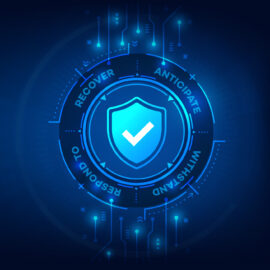
Failing to test your organization’s cybersecurity controls is like having a security system installed in your house … then leaving home without checking your locks. It’s an apt analogy that underscores a critical truth about IT resilience: Trust in your systems is good, but verification is essential.
The importance of testing and assessing cybersecurity controls cannot be overstated. For organizations of all sizes —especially those heavily reliant on digital infrastructure — these controls are often the last line of defense against increasingly sophisticated cyber threats. Yet, despite the effort spent creating policies, deploying systems, and drafting recovery plans, organizations often neglect to validate whether those solutions perform as expected.
Here, we’ll explore why testing these controls is non-negotiable, what it involves, and how organizations can confidently prepare for the unexpected.
The Why of Cybersecurity Testing
Creating resilient cybersecurity measures is like building the walls of a fortress. But how do you know if they can actually withstand an attack? That’s what regular testing is designed to uncover.
Key Reasons for Testing:
1. Identify Vulnerabilities Before Hackers Do:
Security controls can have gaps, misconfigurations, or unknown vulnerabilities. Testing allows you to find these weaknesses proactively, minimizing the risk of exploitation.
2. Ensure Systems Work as Intended:
Just because a control was successfully implemented doesn’t mean it’s operating correctly. Testing ensures that backups, firewalls, and endpoint protections actually work when needed.
3. Adapt to Evolving Threats:
Cyber threats and tactics evolve rapidly. Your defenses must keep pace, and only regular testing can confirm whether they are.
4. Strengthen Incident Response Readiness:
Teams that have rehearsed cyber incident responses in testing scenarios perform significantly better under pressure during real events.
5. Maintain Compliance:
Many regulatory frameworks require periodic control assessments, and insurers often mandate evidence of functional controls as a condition of granting policies or payouts.
How to Test Your Cybersecurity Controls
Testing your security measures might sound daunting, especially for smaller organizations, but it’s entirely manageable when approached methodically. Below are steps to ensure your cybersecurity controls are both efficient and effective.
1. Start with Self-Assessments
Before bringing in external resources, leverage self-assessment tools to gain a baseline understanding of how your controls perform. Focus on foundational controls like backups, endpoint protections, multi-factor authentication (MFA), and patch management.
- Conduct periodic vulnerability scans to check for exploitable risks.
- Use vendor-specific testing tools for systems such as backups (e.g., Veeam or VMware testing tools).
2. Audit Backups Regularly
Securing an organization against ransomware or major incidents depends on reliable backups. How can you confirm they’re viable?
- Automate testing for backup recoverability using available tools, prioritizing missions-critical systems.
- Manually test full-system restores annually to ensure a seamless response in emergencies.
3. Simulate Security Incidents
Test your incident response plans through simulations. Practices like tabletop exercises, where staff walk through hypothetical cybersecurity scenarios, make real-life responses far more effective.
Why it matters:
During actual incidents, stress can hinder critical thinking. Teams that have rehearsed will know their roles, responsibilities, and countermeasures cold, reducing panic and missteps.
4. Partner for Deeper Assessments
While smaller organizations may rely on managed service providers (MSPs) to monitor and manage controls, even MSP-driven environments benefit from advanced assessments. Options include penetration testing services or partnering with firms that specialize in ethical hacking.
- Example tools include Tenable and Qualys for vulnerability assessments beyond surface-level scans.
- Specialized consultants can uncover weak points by simulating real-world attack techniques.
5. Validate Your Patch Management Practices
Patch management is one of the most vital tasks in cybersecurity, and its complexity should never be underestimated. From OS and application updates to firmware fixes, even a small oversight can leave systems exposed.
Tips for Mastering Patch Management:
- Maintain an up-to-date inventory of all systems and software to prevent gaps.
- Test patches in controlled environments to identify compatibility issues before deployment.
- Regularly review log reports to ensure accurate patch application.
- Conduct vulnerability scans to confirm patched systems are secure.
Beyond the Tech: Training Your People
Most cybersecurity incidents stem from human error. Even the best technical solutions can fail if employees aren’t adequately trained to recognize and respond to threats. A single misplaced click on a phishing email can bypass all other safeguards.
Best Practices for Employee Cybersecurity Training:
- Relevant Content: Teach employees about current threats such as phishing, ransomware, and social engineering. Avoid outdated training modules.
- Regular Sessions: Quarterly or monthly refreshers reinforce awareness consistently.
- Quizzes & Simulations: Test knowledge through practical exercises, like phishing awareness campaigns, to ensure retention.
- Foster a Culture of Reporting: Employees must feel safe self-reporting mistakes (like clicking a suspicious link) without shame or fear of punishment. Early reports save minutes, and those minutes can save millions of dollars.
Building a Resilient IT Department
Organizational resilience stems from the trust that systems will work as expected when needed. Continuous improvement, extensive testing, and investing in both the human and technological components of your environment are not luxuries; they are necessities.
Remember: Cybersecurity is not static. It is an ongoing process of refinement designed to adapt to changing risks and organizational needs.
If you’re ready to solidify your protective measures and start verifying your systems and processes, now is the time to act. Reach out today to schedule a free consultation to learn how to fortify your defenses.
Because when it comes to cybersecurity, hope is not a strategy—but testing is.




